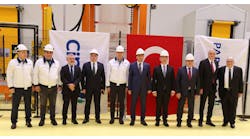The photovoltaic (PV) industry is the fastest growing industry in the world, with a promising chance to remain the fastest growing industry for the next decade. The solar inverter market was $3.1 billion in 2008 and is forecasted to be over $12.0 billion in 2014, according to a new ARC Advisory Group study.
Solar inverters are a critical component in PV systems because the DC voltage from a solar panel has to be converted to AC, so the market for solar inverters of any size in any application is entirely dependent on the related market for PV systems.
"This is a very dynamic market that is going against the tide of the remnants of the global recession, and while Europe has been a leader in PV solar farm implementations, China and the U.S. are racing to take over the lead. High growth has attracted the large automation suppliers, such ABB, Eaton, Emerson, GE Energy, Schneider Electric, Siemens and Elettronica Santerno," according to Steve Clouther, the author of ARC's "Solar Inverter Worldwide Outlook."
The worldwide installed capacity of the solar PV power escalated from 1.3 GW in the year 2001 to a little less than 15.0 GW by 2008. The installed global solar PV market grew to more than 20.7 GW in 2009, representing growth of about 38%on 2008. For a point of reference, in the period from 2001 to 2008, the solar PV market grew at a compound annual growth rate greater than 60%.
Despite the current global economic problems, China and the United States are aggressively going after Europe's leading position in the solar power industry. China is already the world’s biggest producer of solar panels.
However, China still exports 90% of the solar panels it produces to markets such as Germany, Spain, Japan and the U.S. China is striving to become a meaningful market for solar energy and has adopted the European model of subsidizing the industry in an attempt to get it off the ground. It has a target of 20 gig watts of installed capacity by 2020.
It is the U.S., however, which has recently attracted the most attention globally from the solar industry. Legislation is a sure way to increase the use of solar power, so, much attention followed on the heels of the Obama Administration's stimulus package which contained grants and tax breaks for solar power.



